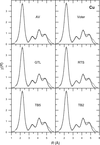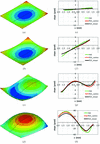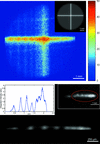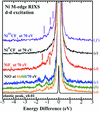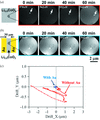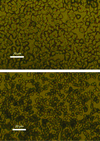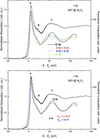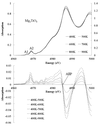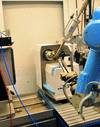issue contents
July 2013 issue

Cover illustration: Sequence of SAXS patterns from the formation of jarosite at 368 K (see Brand, Scarlett, Grey, Knott and Kirby, pages 626-634). The data are represented in a three-dimensional plot with q along the x-axis, scan number (time) on the y-axis and intensity along the z-axis.
facility information
research papers
Open  access
access
 access
accessThe interplay between X-ray reflectivity, X-ray absorption and photoelectron attenuation in the photoelectron emission process is analyzed. The optimal X-ray incidence angle to maximize the photoelectron signal is evaluated in a wide VUV to hard X-ray energy range.
The design and commissioning of a novel monochromator approach based on off-axis reflection zone-plate arrays for experiments with ultrashort soft X-ray pulses is described.
Open  access
access
 access
accessNonlinear optical (NLO) instrumentation has been integrated with synchrotron X-ray diffraction for combined single-platform analysis, examining the viability of NLO microscopy as an alternative to the conventional X-ray raster scan for the purposes of sample centering. Second-harmonic generation microscopy and two-photon excited ultraviolet fluorescence microscopy were evaluated for crystal detection, and assessed by X-ray raster scanning.
The resonant scattering and diffraction beamline P09 at the new third-generation synchrotron radiation source PETRA III has been designed for resonant and non-resonant scattering experiments in the energy range from 2.7 keV to 32 keV requiring small beams, energy tunability, variable polarization and high photon flux.
It is shown theoretically that the asymmetric or inclined double-crystal X-ray monochromator may be used for X-ray free-electron laser pulse compression if the pulse is properly chirped.
Molecular dynamics simulations that employ different interatomic potentials are found to vary significantly in their predictions of XAFS scattering path cumulants and synthetic XAFS spectra for metallic solids.
Open  access
access
 access
accessThe shape of cryogenically cooled monochromator crystals deformed by the heat load of the X-ray beam is derived from rocking curve measurements at various vertical positions of a narrow-gap slit downstream from the monochromator. Experimentally, it is observed that the crystal shape changes from concave to convex when beam power increases. The observations are accurately modelled by finite-element analysis, showing an excellent quantitative agreement with experiments.
Three-dimensional structures of Escherichia coli overexpressing a metalloprotein ferritin were visualized by synchrotron radiation microtomography.
A windowless gas reactor is coupled with a VUV synchrotron beamline. This new set-up enables various kinds of planetary upper atmospheric conditions to be simulated.
Open  access
access
 access
accessLarge-aperture focusing lenses have been evaluated for momentum-resolved and flux-limited spectroscopy with hard X-rays.
Open  access
access
 access
accessThis paper presents an imaging model and a reconstruction algorithm for obtaining X-ray beam cross-sectional images from the data recorded by an X-ray beam monitor based on a coded aperture camera that collects radiation scattered from a thin foil placed in the X-ray beam at an oblique angle.
The uncertainty in temperature-dependent EXAFS measurements on CdTe is discussed, focusing on the first-shell bond thermal expansion, parallel and perpendicular mean square relative displacements and the third cumulant.
M-edge XAS on a series of 3d metal complexes and M-edge RIXS on a covalent complex are reported for the first time, encouraging synchrotron-based M-edge measurements on more complicated samples in the future. Application of a superconducting tunnel junction X-ray detector to M-edge measurements is also discussed.
Open  access
access
 access
accessA photoemission electron microscopy measurement system on insulating samples was established at the BL17SU beamline of SPring-8 by utilizing an Au pattern evaporation technique combined with photon-induced surface modification.
This paper reports the results of time-resolved synchrotron small-angle scattering where natrojarosites were synthesized in situ to observe the species produced at the earliest stages of nucleation. A single nucleation event is observed, followed by the development of an amorphous precursor phase before jarosite crystallizes.
The local structure of the Ni atoms located at the interfaces formed by the deposition of NiO on selected oxides has been studied by means of XANES at the Ni K-edge.
short communications
The absorption intensity invariant point (AIIP) was found to be between the pre-edge and post-edge in XANES spectra of various titanium compounds. Use of the AIIP peak intensity as a standard point enables a quantitative comparison of the intensity of the pre-edge peaks in various titanium compounds over a wide temperature range.
The flexible geometry of a multipurpose κ-diffractometer has been utilized in the study of a range of various thin film systems.
beamlines
Open  access
access
 access
accessThe updated macromolecular crystallography beamline I911-3 at the MAX II storage ring is described.
Open  access
access
 access
accessThe optical design of the SPSXS beamline at the APS is described. The beamline will allow time-resolved experiments in the picosecond range with moderate resolution and relatively high linear and circular polarized flux.
Open  access
access
 access
accessA description of the new ESRF BioSAXS beamline is given. The beamline presented is dedicated to small-angle X-ray scattering of macromolecules in solution operating with a high-throughput sample-changer robot and automated data analysis for quality control and feedback.
current events
Free 



 journal menu
journal menu

























